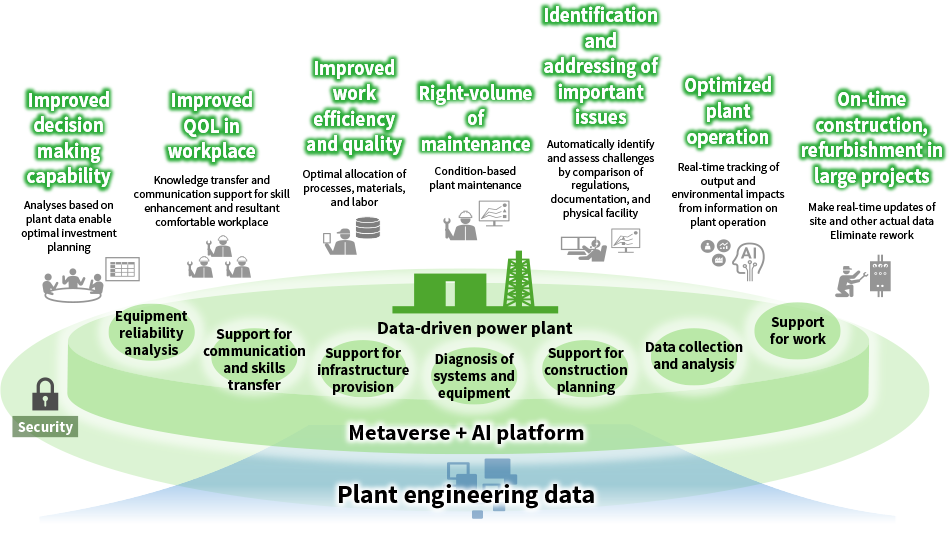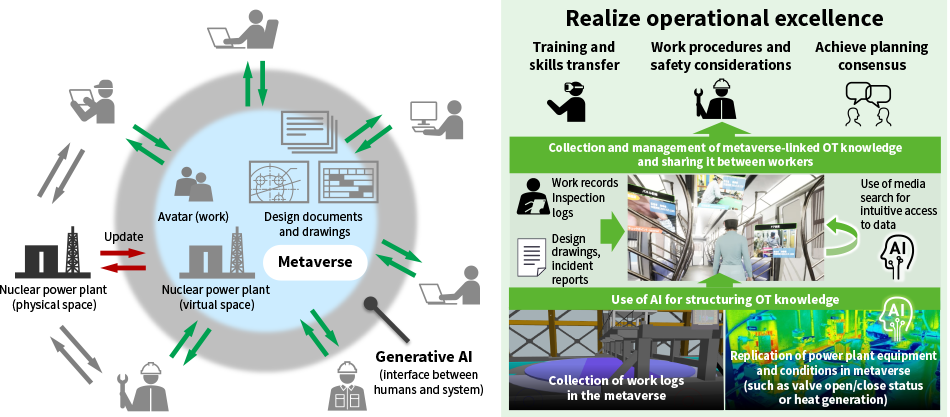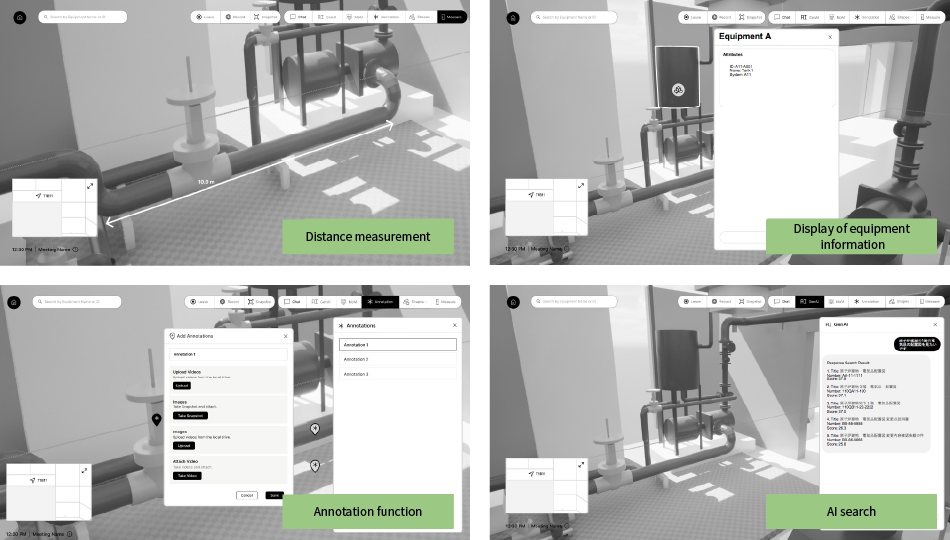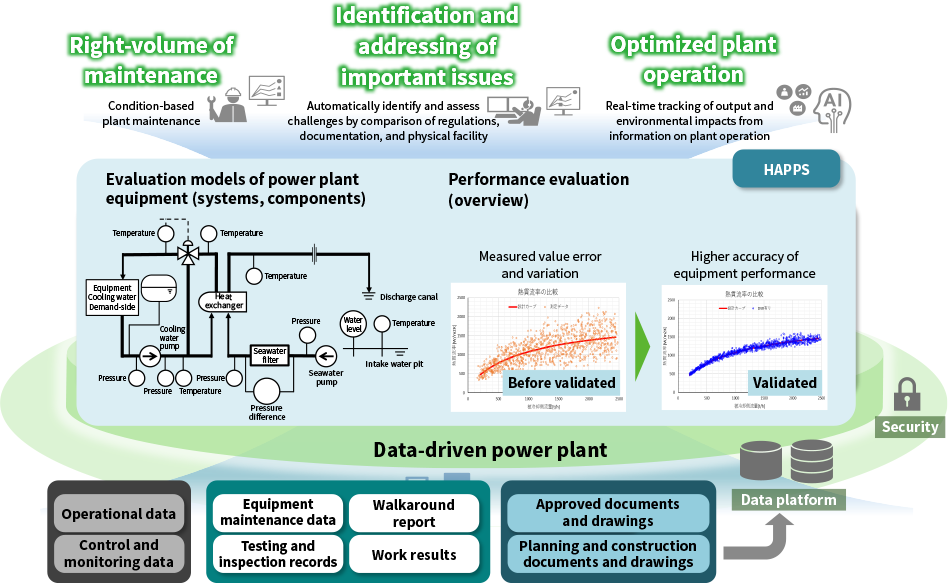Hitachi’s Efforts in the Nuclear Sector (3)Enhancements to Nuclear Power O&M Using Digital Technology
Highlight
As the world continues to warm, the pursuit of carbon neutrality is becoming increasingly urgent. The Seventh Strategic Energy Plan adopted by the Japanese Cabinet in February 2025 anticipates making maximum use of nuclear power generation as a decarbonized energy source that does not emit CO2. In addition to making steady progress on the restarting of existing plants, maintaining high rates of utilization in these plants after they are back online will also play an important part. Meanwhile, the nuclear power industry is just one of many sectors where the ongoing trends in Japan toward a falling birthrate, aging population, and progressively shrinking workforce are raising concerns about labor shortages and skills transfer. In response, Hitachi Group is leveraging digital technologies in its efforts to overcome these challenges. This article describes digitalization initiatives for nuclear power plants that include use of the metaverse and the monitoring and diagnosis of operating plant performance.
1. Introduction
There have been calls in recent years for achieving carbon neutrality as part of global action on climate change. Japan was one of the countries at the 28th Conference of the Parties to the United Nations Framework Convention on Climate Change (COP28) in 2023 calling for a tripling of nuclear generation relative to a 2020 baseline2). Going forward it is anticipated that nuclear power generation will play an increasingly important role internationally. Japan, meanwhile, has adopted its Seventh Strategic Energy Plan1) (in a February 2025 Cabinet decision) that seeks to reduce greenhouse gas emissions by 46% by FY2030 (relative to FY2013) and achieve carbon neutrality by 2050. The plan also lays out policies for making maximum use of decarbonized energy sources such as renewable energy and nuclear power rather than treating these two forms of power generation as an either-or proposition. This reiterates the importance of nuclear power and the expectation that it will serve as a decarbonized energy source that does not emit any CO2 in the generation process.
The use of existing plants will also be important if nuclear power plants are to be effective as a carbon-free source of electricity generation. In addition to restarting plants, this should include equipping plants with the capabilities for a 60-year operating life with long-cycle operation and improvements in equipment utilization achieved by optimizing the frequency and volume of maintenance work so that routine inspections could be completed within a shorter period during plant shutdown. Given the trend toward a shrinking working population, there is a need both to pass on the expertise of experienced workers and to make productivity improvements so that maintenance and management can be undertaken with a small workforce without compromising safety and quality. This will be needed to ensure that operation, maintenance, management, and the execution of work take place in a sustainable manner across every step in the life cycle of a nuclear power plant, from design to construction, operation, maintenance, and decommissioning.
Digital technology shows promise as a means of overcoming these challenges and the nuclear power industry is among those working on practices such as the development of digital twins and the use of generative artificial intelligence (AI), both in Japan and overseas. A particular feature of the nuclear power industry is that, in addition to the engineering-related text data held in cyberspace, the involvement of physical objects in tasks such as on-site work and equipment management means that the collection, aggregation, and use of data generated in the plant is also becoming more important than ever. It is anticipated that the use of digital technology will advance by measures such as ensuring that plants are fully equipped with easy-to-use devices for the efficient access and viewing of desired data from very large data sets and people who know how to use them, all of which must operate on communication infrastructure that provides secure transmission of data. This article describes work being done on the digitalization of nuclear power plants, including use of an in-plant metaverse and the Hitachi Advanced Plant Performance Diagnosis System (HAPPS).
2. Use of Digital Technology at Nuclear Power Plants
Figure 1—Data-driven Power Plant for Innovation in Stakeholder Activities AI: artificial intelligenceThe diagram shows how the platform collects plant data and uses digital twins to optimize power plant design, operation, and maintenance.
AI: artificial intelligenceThe diagram shows how the platform collects plant data and uses digital twins to optimize power plant design, operation, and maintenance.
Hitachi Group is developing a wide range of solutions that use digital technologies to support the safe and secure operation of nuclear power plants. Its vision for the future is one in which these solutions run on a digital twin platform that replicates power plants in virtual space, thereby creating data-driven power plants that utilize actual plant data (see Figure 1). This involves collecting and aggregating planning, design, and plant data and then putting the results of its analysis to use in the operation of the plant, and also going on to use collected data to support decision making. The data will also be utilized across each phase, from design to construction, operation, maintenance, and decommissioning, to deliver value and resolve problems by addressing the various needs and other challenges that confront stakeholders.
2.1 In-plant Metaverse
The metaverse is a useful tool that allows users from different locations to share a virtual space where they can communicate with one another and engage in actions while viewing the same virtual environment. While there are established processes for the work done at nuclear power plants, a wide variety of routine communication such as the sharing of information between workers also takes place, such as informing the office about the condition of equipment or the progress of tasks in the plant and updating the plant on the outcomes of reviews conducted at the office.
Accordingly, the goal is to build systems that use three-dimensional (3D) scanning to replicate nuclear power plant equipment in the metaverse so that it can be used as a platform for the collection and presentation of plant data, with use of generative AI to help put this data to work. By replicating power plant equipment and tasks in a virtual space, this use of the metaverse for nuclear power plants3) should make communication more efficient by eliminating physical and temporal constraints and enabling different stakeholders to view the same information as they go about their work.
Figure 2—How Metaverse is Used at Nuclear Power Plants OT: operational technologyOperational excellence at nuclear power plants is achieved using three-dimensional (3D) models and AI.
OT: operational technologyOperational excellence at nuclear power plants is achieved using three-dimensional (3D) models and AI.
Figure 2 shows how the metaverse can be put to use at a nuclear power plant and the associated use of operational technology (OT) knowledge. This replicates the 3D layout of the nuclear power plant in a virtual space together with information on power plant equipment and work, updating this information as needed. It also allows for the embedding of a range of knowledge in the virtual environment that the user can then manipulate and search in an intuitive manner using AI, including work logs, design documents, drawings, and video or still images. AI, including generative AI, can serve as an interface between humans and the system. This helps to achieve operational excellence at nuclear power plants.
For example, by enabling stakeholders to reach a quick agreement over the planning or progress tracking of on-site work, the system can facilitate skills transfer and improve the safety and quality of activities such as routine inspections or large projects that take place in the plant. The system should also reduce the risk of problems such as rework and ensure that work goes according to plan by enabling communication between the necessary people, when needed and with reference to the same information.
Generative AI is making rapid progress in fields like natural language processing and video synthesis, having the ability to generate high-level text, image, and other content from multi-modal inputs such as text, speech, and images. It also shows great promise for improving the efficiency of work in the nuclear power industry where the number of documents is large, including through the search, collection, and summarizing of design documents; comparison and analysis based on multi-modal information; accumulated knowledge; and use of interactive and other methods to assist with the generation of text.
In addition to point cloud scanning and techniques for importing into computer-aided design (CAD) that can acquire and replicate the layout and positioning of 3D spaces and equipment, accumulating different forms of plant data in a 3D space will also require techniques that can represent and collect human actions as 3D data. Moreover, generative AI can also facilitate better use of knowledge by linking the information generated by equipment and worker activity in the plant with document information held in the office.
Figure 3—Example Functions for In-plant Metaverse A metaverse equipped with distance measurement, equipment information display, comment function, and AI search functions helps to improve the safety and efficiency of work in the plant.
A metaverse equipped with distance measurement, equipment information display, comment function, and AI search functions helps to improve the safety and efficiency of work in the plant.
Figure 3 shows example functions from a system being developed to provide an in-plant metaverse. A 3D nuclear power plant is being constructed in the metaverse from sources such as detailed 3D CAD design information, point cloud data, and images of the plant itself. Authorized users can then log in to make shared use of the same virtual space. This can provide them with a good idea of the situation in the plant without having to visit in person, including distances, obstacles, and information about equipment. This enables more efficient on-site work and installation by allowing tasks to be performed in the metaverse, such as verifying the route design and layout of piping, cables, machinery, and other equipment or checking whether there is space for welding work.
When the metaverse is combined with generative AI, users can use a chat-based interface to search for and view information about equipment in the metaverse whenever they need to. This should enable faster decision making because it allows engineers and other stakeholders to appear together in the metaverse as avatars and hold online meetings on-site, using generative AI to take the meeting minutes and post the matters raised in the virtual space.
In addition to significant improvements in the operational efficiency of nuclear power plants, the use of digital technologies like these can also help to maintain safety. One possibility would be to run simulations in a virtual space to identify latent risks before they manifest and determine how to prevent them from happening. The remote access capability also means that experts can quickly investigate how to deal with problems without having to visit the site in person.
2.2 Performance Monitoring and Diagnosis of Operating Plants
Hitachi has developed HAPPS for monitoring and diagnosing the performance of operating nuclear power plants to improve their reliability and efficiency4), 5). HAPPS evaluates data using physical models based on plant design information and performs statistical processing of errors such as instrument drift to determine equipment values that are close to actual performance and assess the extent of degradation.
By doing so, HAPPS can deliver value in a variety of different forms. These include monitoring instrument drift; detecting problems such as leaks; assessing the performance of heat exchangers, pumps, and other such equipment; and tracking cooling loop functions and the thermal balance with high accuracy. This is expected to improve plant utilization by optimizing the frequency and content of the maintenance work conducted during power plant shutdowns. The technology can also facilitate more advanced plant maintenance practices through use in tandem with applications that support the visualization of equipment condition, the prioritizing of maintenance work, and the planning of plant investment, such as the Lumada Asset Performance Management (APM) product developed by Hitachi Energy Ltd.6). In the future, Hitachi’s goal is to ensure the efficient operation and maintenance of power plants without compromising the safety and reliability of equipment by enabling maintenance to be based on engineering data encompassing operation, maintenance, and documentation (see Figure 4). Ongoing improvements should also be possible through the collection and analysis of data to identify trends in equipment deterioration and to formulate optimal maintenance plans.
Figure 4—Example Monitoring and Diagnosis of Plant Performance HAPPS: Hitachi Advanced Plant Performance Diagnosis SystemHAPPS uses physical models to optimize plant performance through the precise monitoring and assessment of equipment condition.
HAPPS: Hitachi Advanced Plant Performance Diagnosis SystemHAPPS uses physical models to optimize plant performance through the precise monitoring and assessment of equipment condition.
3. Conclusions
A strength of the Hitachi Group in its efforts to bring about digital transformation in the nuclear power industry is that it can work together as One Hitachi combining the three strands of IT, OT, and products. By doing so, it will continue to support the safe and secure operation of nuclear power plants and contribute to achieving carbon neutrality. In the future, Hitachi will continue to leverage digital technologies in its efforts to improve work efficiency at nuclear power plants and in skills transfer and workforce training so as to enhance the reliability of nuclear power generation and ensure safe and secure operation. The nuclear power business of Hitachi Group will continue to push ahead with digital technology as it contributes to the creation of a sustainable society.
REFERENCES
- 1)
- Cabinet Decision on the Seventh Strategic Energy Plan(2025.2)
- 2)
- Newspaper of the Japan Atomic Industrial Forum, Six More Nations Sign up to Declaration for Tripling of Nuclear Power, (Nov. 2024) in Japanese
- 3)
- H. Ohashi, et al., Industrial Metaverse, Thermal and Nuclear Power Generation, October Feature Issue, pp. 659 to 668 (Oct. 2023) in Japanese
- 4)
- Y. Hidaka, et al., Development of Hitachi Advanced Plant Performance Diagnosis System, 2022 Fall Conference, Atomic Energy Society of Japan (Sept. 2022) in Japanese
- 5)
- A. Tamura, et al, An Estimation Method for Bias Error of Measurements by Utilizing Process Data, An Incidence Matrix and a Reference Instrument for Data Validation and Reconciliation,ASME J of Nuclear Rad Sci. Oct 2023, 9 (4) (2023.9)
- 6)
- Hitachi News release, Hitachi Energy launches the Next Generation of its Asset Performance Management Solution, Lumada APM (2023.10)



